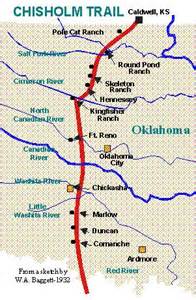The Chisholm Trail
The Chisholm Trail was a commercial route named for a trader. A combination of disease and war had drastically reduced the markets for Texas cattle. The end of the Civil War brought new opportunities, and drovers took advantage of an existing route and set of outposts to move their cattle northward, through Oklahoma and Kansas. In 1867, Illinois entrepreneur Joseph G. McCoy got permission to build a loading area near the Kansas town of Abilene. The cattle drive became a common appearance. In just four years, numbers exceeded half a million. A regular on the route was trader Jesse Chisholm, who had a ranch in Wichita, Kan. Traders originally called the route the Abilene Trail and the Kansas Trail but soon switched to calling it the Chisholm Trail; the name stuck. A printed reference to the Chisholm Trail appeared in a Kansas newspaper in 1870.
Historians estimate that in all, more than 5 million cows made the trip along the Chisholm Trail from ranches in Texas to stockyards in Kansas. The Chisholm Trail was not an orderly, neatly kept pathway of refined dirt that led in a straight line from one place to another. On the contrary, cattle herds routinely spread out across the prairie, their accompanying cowboys attempting to keep them going in the correct general direction. Drives that closely followed other drives had quite a challenge sometimes to find grass or other edibles that hadn't been consumed by the drive that had gone before. For nearly two decades, cattle streamed northward on the Chisholm Trail. As the 19th Century progressed, though, cattle drives diminished greatly, for a number of reasons. The most prominent was the increased use of barbed wire, which officially closed the Trail in 1884; by that time, the Trail stretched only partway into Kansas, anyway. |
|
Social Studies for Kids
copyright 2002–2024
David White



 Two major rivers, the Arkansas River and the Red River, and many other smaller waterways provided challenges for such cattle drives, as did rough weather, rustlers, and unfriendly Native Americans, some of which charged a toll for hassle-free passage. Herds numbered in the thousands and could get as far apart as a couple of miles in length along the rough-and-tumble Chisholm Trail. Ranchers generally hired trail bosses and cowboys to drive the cattle north, and these men (for men they invariably were) were generally armed, to protect against a variety of threats.
Two major rivers, the Arkansas River and the Red River, and many other smaller waterways provided challenges for such cattle drives, as did rough weather, rustlers, and unfriendly Native Americans, some of which charged a toll for hassle-free passage. Herds numbered in the thousands and could get as far apart as a couple of miles in length along the rough-and-tumble Chisholm Trail. Ranchers generally hired trail bosses and cowboys to drive the cattle north, and these men (for men they invariably were) were generally armed, to protect against a variety of threats.
